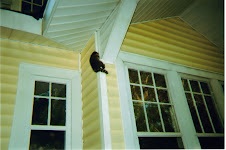



HELLO & Welcome to Garden Daddy here at the urban farm! Today I attended the Jackson Area Beekeeper's Association annual keepers short course. I must say I learned all I ever thought I wanted to know about beekeeping. It was very interesting and I had no idea some of the problems facing not only the bees themselves but for keepers as well.
I have long known about the hive issues going on as far as hive collapse, mite problems and really total disappearance of feral bees as a whole. Beekeepers are in a huge dilemma with keeping so many diseases and just pests in general from destroying the hive and total hive loss. I have learned that the cost of getting honey is about the same as this urban farm's cost of a dozen of this Garden Daddy's eggs...about $10.00 a dozen...and thus around $10.00 per pint. Just kidding on both counts but the "cost per" is not the issue but what real cost is worth the price of pure, fresh and home grown food stuffs. Truly, the eggs from this urban farm are NOT $10.00/dozen but are almost equal with store bought "natural eggs". Of course ALL EGGS ARE NATURAL! But with the ones I have here I consider them basically free range (they range free in their enclosure outside), completely steroid free, non-medicated in no way at all and I only use the natural product of Diatomaceous Earth for both worming and for mite control. We have discussed DE before on this site and you can search online for more information or go back to some earlier blogs regarding that product.
I had to agree to obtain bees this spring, take on a mentor, and give monthly reports for one year at the local JABA meetings, held the first Tuesday of each month. That is the partial running cost of the win. Not to mention I need to order my 3-lbs of bees plus a queen, then some other needed equipment and then I will be only feeding sugar and water to start till weather permits more blooms to arrive in the summer. Then other than weekly checks, they are and can basically take care a lot of themselves. Some maintenance and then yearly medications and you are good to go till fall honey harvest. I will have to add more "supers" later on as they build and add their need for more space for the hive brood and the honey they will make. I am thinking now of hot biscuits and lots of real butter and now...fresh, pure honey!
I will write more later on the subject of bees. If you remember I wrote last summer that I had not seen any bees really here all last year and I blamed my poor cucumber harvest on that fact. So hopefully this summer my home garden here at the urban farm will improve AND give up some good honey as well. So till later, I leave you today with our ongoing urban farming affirmation....and coming yet another step closer to our goal here: "URBAN FARMING: ONE EGG AT A TIME!"


















